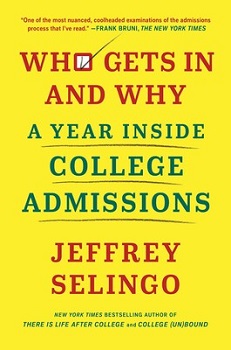Who Gets In and Why: a Year Inside College Admissions by Jeffrey Selingo
First, a warning: If you are a high school senior or parent of a high school senior currently awaiting news of college acceptances, do not read Who Gets In and Why: a Year Inside College Admissions by Jeffrey Selingo. Parents of younger teens—this book is for you, although it is well-researched, fascinating and of interest to anyone who is curious about the sorry state of higher education admissions and how we got there.
Selingo begins his book with the acknowledgement that the high school Class of 2021 faces all the regular challenges of this stressful season, plus the unprecedented difficulties of completing their senior year during a pandemic. They’ve had online classes, SAT and ACT test cancellations, elimination of college tours, a dearth of extra-curricular activities and volunteer opportunities, abbreviated sports seasons and massive uncertainty about how all of this will affect their chances of getting in to the school of their dreams.
Add in extra financial strain on families brought on by pandemic-related layoffs and you have increased anxiety levels exponentially. But even in a “normal” year, it’s no picnic, and Selingo carefully examines how and why the system evolved over time into the horror show it is today.
A longtime journalist reporting on higher education, Selingo secured inside access into the admissions processes at the University of Washington, Davidson College, and Emory University. Though each has its own approach, Selingo shows that large public institutions, tiny liberal arts colleges and urban, private research schools all struggle to select an incoming class. In years past, all three would have been far less choosy than they are today, but larger pools of applicants, rising tuition costs, college rankings and an increased focus on marketing have made them more desirable to prospective students. With class sizes remaining stable, a higher number of applicants means a smaller percentage of acceptances, resulting in increased selectivity. The next crop of students translates low-acceptance rates into exclusivity and prestige, and a vicious cycle is perpetuated.
Selingo explores the ins and outs of early decision and how students can get an edge. Hint—it’s not by photoshopping your face into a crew team photo (that could land you in jail). Sports are also not a ticket to a coveted “free ride” (a tiny percentage of athletes are awarded scholarships each year) although they are most definitely a foot in the door, particularly at elite schools. Apparently tiny Amherst College has more athletes than the University of Alabama and coaches across the country need to fill teams. So spending a fortune on high school club sports may pay off after all, if attending a name-brand college is important.
Selingo repeatedly warns that chasing the same top schools is a fool’s errand, and advises that there are many excellent institutions across the country that are more “buyer” than “seller.” Parents would be smart to pay close attention to net price calculators and take a realistic look at their finances. For families with household incomes nearing $100,000, the chances of need-based scholarships are minimal. Merit scholarships, particularly at elite schools where every student has a 4.0 and dazzling test scores, are equally elusive.
This book is chock full of interesting details and helpful advice for prospective applicants. Selingo also offers his suggestions for completely overhauling the college admissions system—a tall order at odds with the $9 billion industry that profits from and perpetuates it. Readers will be left feeling infuriated at the current system, and grateful for their own college acceptances.
—Christine Perkins is the executive director of the Whatcom County Library System (WCLS). WCLS brings the power of sharing to rural Whatcom County, including a wide variety of online resources at https://www.wcls.org/info. Hours and services may have changed due to the pandemic, go to https://www.wcls.org or call (360) 305-3600 before you visit for the most up-to-date information. Whatcom County Library System is a separate entity from Bellingham Public Library, although the two systems often partner.
(Originally published in Cascadia Weekly, Wednesday, March 3, 2021.)

